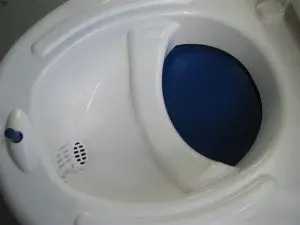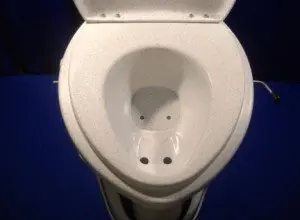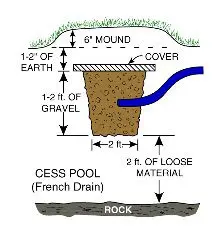Urine diverting toilets are a significant improvement over older composting toilet designs, that combined urine and solids together in one tank. Urine diverting toilets eliminate most of the liquids in the composting chamber, substantially reducing odor, and making the break down of solids much easier.

Urine naturally drains forward when men or women sit on the toilet
Although most composting toilets work fine when properly installed and very carefully operated, I do frequently hear complaints from people who say their toilets “are not working” or that they simply smell bad.
The main problem is usually too much liquid from urine. If the contents are too wet, you will not get compost. You will get a sodden, stinking mass of sewage. Odor problems can certainly occur. In theory, the urine should be evaporated by the built in heater and/or fan. But in practice, the volume of liquid may simply be too great for this to be accomplished. Emptying a toilet full of un-composted material is hard to even think about.
To try and solve this problem, many non-urine diverting toilets have overflow drains to handle excess liquid. These drains MUST be clear and working properly. The overflow drain must be led somewhere below the toilet itself so gravity can cause it to flow away. That may be difficult, especially if you are already at ground level or don’t want to cut holes in your floor. Also, you need a sump, container or pit where this excess urine can be stored. If you have a properly working overflow drain, you should have no problems. The overflow will be urine mixed with feces, so it cannot go into the gray water system. It cannot be drained into a pit, and it cannot be used as fertilizer. In other words, it’s a problem.
A better mousetrap?
A superior solution in many ways is a urine diverting composting toilet (also called a urine separating toilet). These have only recently become more widely known. You use the toilet normally, but most of the urine is diverted automatically into a separate container. This means the solid contents remain only slightly moist – perfect for composting. Separating the urine solves the excess liquid problem common to most conventional composting toilets. The urine has not been contaminated with feces, so in many areas it is legal to send it into the gray water system. Typically, this will be a tube running from the urine diverting toilet to the drain below the bathroom sink. Or you can store the urine in a tank, dilute it with water, and use it as fertilizer. It can also simply be led into a small drain pit beside the dwelling.
According to the group SOIL (sustainable organic integrated livelihoods) – a non-profit that builds composting toilets in Haiti – urine diverting toilets are the way to go. They have experimented with many different methods. From their website:
“Urine Diversion toilets have the significant advantage of reducing the amount of waste that needs to be transported therefore reducing gasoline consumption and costs. Because the excreta remains dry, the toilets are also less odorous than other toilet models and very pleasant to use.”
Other advantages
Another advantage of the urine diverting toilet is that no heater is necessary. Some composting toilets made by Envirolet, Biolet and Sun-Mar use heaters of up to 500 watts. That could be a significant cost, with our soaring energy rates. And what is the point of installing a “green” toilet if you use large amounts of electricity to run it? The heaters may eventually fail, costing more money. All manufacturers do have non-electric or 12 volt models, which use little electricity. However, you must be extremely careful to have a working overflow drain in those non-electric toilets.
Urine diverting toilets need only a small, inexpensive, easy-to-replace fan that uses very little electricity. Or they can be hooked up to a solar vent and you can forget about the fan and power use entirely.
Solid human waste is approximately 85% water by volume. This means that a urine diverting toilet will have enormous capacity for its size. The solid material dries out and shrinks dramatically (just like a compost pile in you backyard).
And finally…urine diverting toilets do not have any problems whatsoever with odor – unlike some older models of composting toilets.
Still not perfect
However, even with a urine diverting toilet you still need a way to dispose of the urine. Fortunately, this is fairly easy. Urine is almost sterile (advanced lab techniques sometimes identify a tiny amount of bacteria) and does not pose a health risk.
The easiest solution is to run the urine drain into the gray water system. If you don’t want to go that route, you can build a simple “French drain” to solve the problem. This is a small pit, about 2′ wide and 2′ deep, filled with small rocks. You cover the rocks with landscape fabric and place soil and grass seed on the top.
Run a tube from the toilet, through the wall or floor and directly into the French drain adjacent to the building. This way you will never have to think about the urine again, as it is getting disposed of constantly.
You can also store the urine in a plastic tank, and dilute it with water 10:1. It is then exceptionally good fertilizer.
Many people install the smaller urine separating composting toilets on boats and in RVs. In this case, the urine can be dumped in any conventional toilet or outhouse as needed.
- drainage pit
- Urine diverting toilet urine drain connections connection
- Store in a tank. Dilute with water 10:1 and use as fertilizer
Capacity
Some urine diverting toilets, such as the Nature’s Head, are smaller, self contained units suitable for 2 people full time or weekend use for up to 4 people. The larger Separett toilets have more capacity and are suitable for a family and general household use. Either toilet will be emptied about once every 4-5 weeks with full time use. This takes between 2 and 3 minutes, and is not unpleasant. Unless you have just used the toilet, there will be little or no odor when you empty it. Urine diverting toilet seats are available for the handy do-it-yourselfer that wants to build their own urine diverting toilet system.






Hi, nice article. I’m looking for a urine diverting toilet that is also water flush gravity-low-flow, like foot pump toilets you find on RVs/boats. We are installing a home, central compost toilet like the Sun-mar Centrex but that model mixes the solid and urine together, which we don’t want. I also don’t want to poop into a coffee filter every time like you have to do with dry, urine diverting toilets. Does anyone make a central compost system with a low-flush, urine diverting toilet? Thanks for your help!
Hi,
You definitely do not need a coffee filter for a urine diverting toilet. That is only one toilet – the Airhead.
If you add flush water, that water will have to be dealt with. If it rinses the bowl where the feces go, then it is contaminated and must be treated as sewage (complex, and very expensive.) A dry urine diverting toilet is far cheaper and simpler.
Central systems sound good on paper, but in practice they pose some problems. Your central storage tank will be full of sewage. It will be difficult and unpleasant to empty.
In my opinion, you are better off with self contained dry urine diverting toilets.
We have had our urine deverting toilet for several years now just the twomof us. the french drain is on a slop and now the urine has started to back up. i ran a plumbers snake and line is clear. what is the problem? i relly dont wah to have dig the entire pit up.
The problem is something is blocked. You will have to investigate, sorry to say.